10 Emerging New England Artists
A Jury of Nine Selects an Exceptional Ten
By: Michelle Aldredge
A young artist, fresh out of graduate school, may be what springs to mind upon hearing the phrase “emerging artist,” but as ANE’s third annual emerging artist list proves, this idea is a stereotype. Our 2020 list contains MFA graduates, self-taught artists, and a range of makers from 25 to 69 years old.
Indeed, satirical humor permeates both Rosemary Mack and Jackson Tupper’s art; despite 41 years separating them, they both poke fun at contemporary life in smart, unexpected ways. Two artists, Mack and Brett Cimino, are self-taught and embraced art after careers as a baker and plumber, respectively. Cimino turned to art after an accident and says it saved his life. And Matt Tracy took a hiatus from art-making to co-own and operate an organic farm full-time for 15 years before returning to his studio practice and merging his interest in ecology and maps with his distinct absurdist humor. Two of the artists with master’s degrees, Jazzmen Lee-Johnson and Glenn LaVertu, take a multidisciplinary approach. Lee-Johnson works across dance, animation, and music to explore the African diaspora, while LaVertu mashes together 2D, 3D, and 4D media to dissect the American gun debate. And four of the artists on this year’s list find inspiration in nature—Megan Bogonovich and Madge Evers, whose work shares an otherworldly quality, as well as Sara Inacio and Devon Kelley-Yurdin, who each have an active social practice that dovetails with their love of more traditional media.
To select these artists, Art New England reached out to nominators from each state who regularly engage with artists throughout the region: Nick Capasso, director of the Fitchburg Art Museum and Lisa Crossman, curator of the Fitchburg Art Museum in Fitchburg, MA; Melanie Carr, director and curator of Melanie Carr Gallery in Essex, CT; Kelly Holt, independent curator and curator at Spruce Peak Arts in Stowe, VT; Marcia Minter, creative consultant, curator, and co-founder of the Indigo Arts Alliance in Portland, ME; Jonny Skye, owner and curator of Skye Gallery in Providence, RI, and Jennifer Dalton Vincent, executive director of Providence ŃCityArts! for Youth in Providence, RI; and Bill Stelling and Karina Kelley of Kelley Stelling Contemporary in Manchester, NH.
MEGAN BOGONOVICH
NORWICH, VT
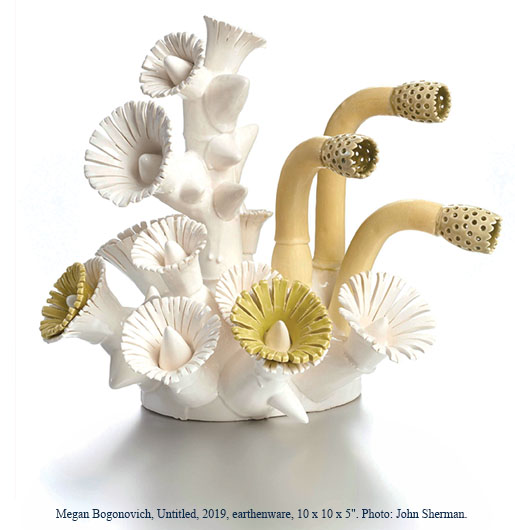
“Megan Bogonovich is a talented, quirky ceramic artist…who creates ethereally beautiful art objects [that look] like a fantasy coral reef,” say Bill Stelling and Karina Kelley of Kelley Stelling Contemporary.
Though Bogonovich earned an MFA in painting at the University of Montana, Missoula, she now creates otherworldly biomorphic ceramic sculptures in her converted garage. Her works are enchanting and unexpected and suggest a fantastical garden, an environmental mutation, or a subconscious dreamworld where desire has taken botanical form.
The 43-year-old’s sculptures exude contradictions: they are familiar, but alien; handmade, but seemingly fabricated; joyful, yet tinged with poignancy. The artist embraces a “feminine handmade decorative element” in her art, while simultaneously achieving a “plastic” quality that imparts a “manufactured look.” She builds her sculptures from molds and makes them in groups. “I keep the connection points raw and let the build remain, at times, inelegant,” she says. “I hope to have the look of a quick and spontaneous assembly regardless of the technical nature of the ceramic material.”
Her pieces take many trips through the kiln and color is added in layers. “The resulting accumulation creates a joyful, abundant, overgrown beast of a garden,” Bogonovich says. “Inspired as much by dollar store plastic flowers as the natural environment, I’m looking to the loony boldness of nature over its prettiness.”
Bogonovich had shows at Gravity Gallery in North Adams, MA, and Kelley Stelling Contemporary in Manchester, NH, in 2019. She is currently selling her sculptures through The Shop Floor Project in the United Kingdom.
BRETT CIMINO
GLOCESTER, RI
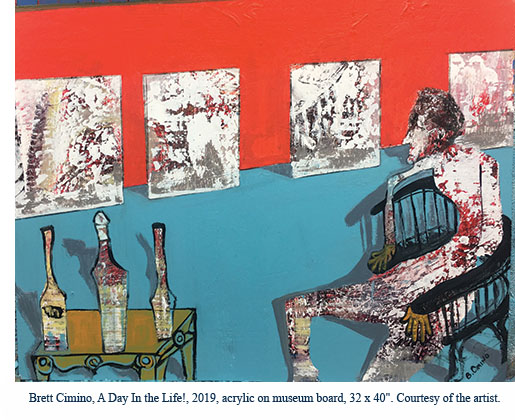
“Rhode Island painter Brett Cimino came to art mid-life after a long career as a plumber,” says Jonny Skye, owner and curator of Skye Gallery. “Cimino’s paintings are energetic, full of absurdity, terror, the ironies of being human and explore the laments of labor, physical pain, and relationships.”
Though an injury prevented Cimino from continuing his plumbing trade, the 46-year-old has been far from indolent. “For the past six years, I’ve held a full-time job in sales while creating more than 400 paintings and writing three books (a local crime trilogy set in Providence).”
“I think not having formal training has given me an opportunity to find my voice,” Cimino explains. “I am not an idle person, and I thrive on my growth and learning.”
The resulting pieces, with their scrawled writing and distorted figures, feel like emotional processing and hover between memory and dreams. They’re raw and alive, overflowing with feelings ranging from comical and absurd to serious and sincere. “Painting makes me vulnerable and allows me to dive deep into my emotional and imaginative inner life,” explains Cimino. “Some visuals sting so hard that they bring tears to my eyes, with others, a moment of happiness. Either way it’s all about emotion—a feeling of raw nostalgia, the history of a mark that can tell a thousand stories…I paint to process, to filter, and frankly, to stay alive.” Cimino will have a show titled LAMENT at Skye Gallery in Providence, RI, from April 25 to May 17.
MADGE EVERS
HAYDENVILLE, MA
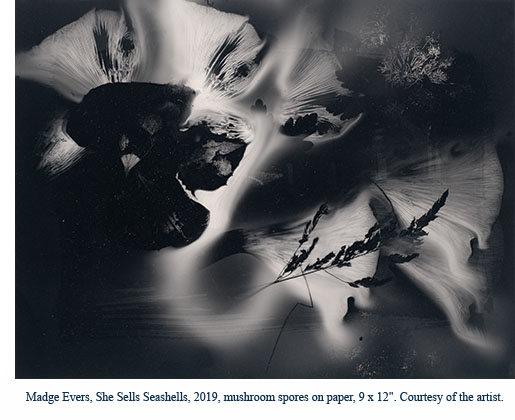
“Madge Evers has invented an entirely new medium to evoke mysterious places where nature and imagination collide: mushroom spore prints,” write Nick Capasso, director of the Fitchburg Art Museum, and Lisa Crossman, curator at the museum.
Evers, who grew up in suburban Connecticut before earning an MA from the University of Rhode Island, makes images that explore the space between accident and design. She creates work by placing mushrooms on paper, gill side down, and introducing various other natural materials. She then waits until the mushrooms release spores that create organic abstractions and photographs them. These stunning compositions conjure magical, ethereal forest scenes and express her love of “experimenting with materials” in a process that “feels like alchemy.”
Her abstract compositions are both ancient and contemporary, otherworldly and familiar, and “depict the purpose with which nature operates.” The beautiful patterns and gradients thrust nature to the forefront, reminding us how little we observe and how much we take our planet for granted. And the 58-year-old is as much a scholar as a magician. Her series A New Herbarium is her interpretation of herbaria—a process dating to the 1600s where plants are preserved for study. She was inspired by Emily Dickinson’s Herbarium, made when Dickinson was a teenager, and Harvard’s Arnold Arboretum has given Evers permission to collect plant material there to create mushroom spore herbaria that will be exhibited at the Arboretum in 2021.
SARA INACIO
PROVIDENCE, RI

“I find there is a haunting beauty in Sara Inacio’s work that is enhanced by the materiality she uses,” says Marcia Minter, curator and co-founder of the Indigo Arts Alliance. “The fact that she has a socially engaged practice that is…informed by her Brazilian cultural heritage, adds an important dimension.”
Inacio immigrated from Brazil at age nine and lived in Massachusetts before moving to Portland to earn a BA in printmaking from the Maine College of Art. Her delicate, visceral prints, books, sculptures, and installations often use animal imagery to explore the “themes of home and transience and the comforts and fears that co-exist in those spaces.”
The themes of “light and darkness, hope and despair” appear in works such as Passage, a glowing installation made of intaglio and silkscreen on Japanese paper, beeswax, dirt, and rocks (which signify individual burdens). Visitors are encouraged to mark their passage by taking a rock and placing it where they choose. Inacio also enjoys experimental printing techniques and has been known to pick up flattened rats from the road to make prints.
“My studio practice also goes hand in hand with social practice,” she adds. In college, she created spaces for students to talk about faith on campus, and in 2017, she and Emma Wolfsohn co-founded the Ears and Hands Collective, which uses printmaking to “help us develop a better understanding of one another’s values and struggles.”
Inacio has had residencies at Art Farm in Nebraska and at Green Olive Arts in Tétouan, Morocco. In September, she will be artist-in-residence for AS220 Industries’ Drink & Ink event.
GLENN LAVERTU
MIDDLETOWN, CT
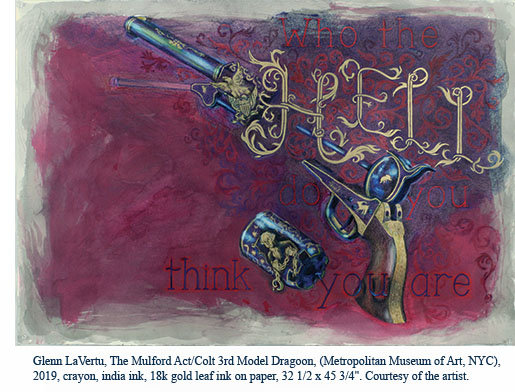
“Glenn LaVertu’s art brain fires on all pistons,” says Melanie Carr, director and curator of Melanie Carr Gallery. “[He] thinks about art critically and passionately—I am in awe of his ability to resolve the clash of where beauty meets danger.”
LaVertu, who teaches at Parsons, grew up in Connecticut, earned his MFA at RISD, and worked as a studio assistant to Sol LeWitt for eight years.
“It’s important for me to be able to say what I want to through a variety of forms,” LaVertu explains, “whether it is abstracted, naturalistic, illustrative, or conceptual; in any medium, from 2D to 3D and 4D, from analog to digital means. Even better when I can mash these various elements together.” LaVertu most enjoys his art practice when he has the “luxury of getting lost in the work.”
Most recently, the artist has been focusing on a series dealing with guns in America: “I recall commuting home on a completely silent train, having just heard the news [about Sandy Hook] alongside hundreds of others of commuters; I felt I had to say something,” says LaVertu. “The first of the series were digital drawings/collages of guns and demons. Those deal with the philosophy of design via the intent of the object’s making: that it has a life of its own born from our malintentions. The larger drawings on paper address the historical, social, and political implications of the gun in the U.S. through studying several Colt firearms seen in area museums. The wound drawings are about a more personal, human, flesh and bone (literally) implication. What I am finishing up now in the 3D work is a mix of all of these.”
JAZZMEN LEE-JOHNSON
PROVIDENCE, RI

“Jazzmen Lee-Johnson speaks to the experience of the African diaspora and the musicality of suffering, persistence, and resistance,” says Jonny Skye, owner and curator of Skye Gallery. “Working across dance, animation, and music, Lee-Johnson discovers imagery that speaks through her family experience in Baltimore, motherhood, life in South Africa and research into archives of African peoples enslaved, and indigenous African spirituality. Lee-Johnson’s work gives life to the present, connects past truths, and builds a future.”
Lee-Johnson grew up in Baltimore before receiving her BFA in Film, Animation, and Video at RISD and her MA in Public Humanities at Brown University, where she was also a Public History of Slavery Fellow at the Center for the Study of Slavery and Justice.
“My work is an interrogative, visceral, playful labyrinth of bodies with their nonlinear histories,” says Lee-Johnson. “I…re-center Black bodies across time and space. In other words, when you look at my work, you feel like dancing and you cock your head sideways when you really see what’s there.”
Recently, she completed a portfolio of nine silkscreens for the first chapter of Grandma’s Lament/Sello sa Nkoko, an audiovisual sciencefiction, afro-surrealist graphic novel and music album. These prints “all allow the body to move,” says Jennifer Dalton Vincent, executive director of Providence ŃCityArts! for Youth.
“My work is driven by a yearning to understand how our current circumstance is tethered to the trauma of the past,” the artist explains. “I read one historical moment through the veiled experiences of many, which inspires me to assign Black bodies new agency.”
Lee-Johnson just began a yearlong fellowship at the RISD Museum and is completing a residency at the Rhode Island Department of Health. She’ll be included in the group show Divine 2020 that runs March 7 to 29 at Skye Gallery in Providence, and Prints and Cassettes will open June 20 at The Wurks in Providence. Lee-Johnson’s happening, Raid the Icebox Now Celebration, will take place at the RISD Museum from 6:00 to 8:30 p.m. on April 16, 2020.
ROSEMARY MACK
DUBLIN, NH

Rosemary Mack’s “practice involves the creation of assemblages and box dioramas à la Joseph Cornell [that] are made from found objects and are thoughtprovoking and fun,” say Bill Stelling and Karina Kelley of Kelley Stelling Contemporary. “She is completely untainted by the concerns of art commerce as practiced in big city galleries. Her enthusiasm and fresh eye make her quite unique.”
Mack grew up in a small town outside Detroit and had a career in another form of art—as a professional cook and baker in Boston and at the MacDowell Colony in Peterborough, NH—before turning to visual art. “Unfortunately, my work lasted only as long as the meal,” she explains. “What I’m doing now is much more satisfying!”
Mack shifted from cooking to art-making in 2015 at the age of 64. In five short years, she has created over 60 artworks. Mack jokes that she has to be productive: “Time is running out.”
Working squarely in the tradition of selftaught artists such as Bill Fink, Mark Hogancamp, and Joseph Cornell, Mack collects a variety of objects ranging from dolls to plastic lobsters to paper ephemera, then constructs these bits into irreverent, whimsical assemblages and dioramas, such as Hope You Like Chinese, which satirizes being born on Christmas (as Mack was). The resulting pieces touch on contemporary culture, memory, excess, and the absurdity of the human experience. They weave in references to President Trump, fairy tales such as “Hansel and Gretel,” and her own family lineage. The oddball, humorous character of the art only adds to its deeper examination of humankind.
Mack’s singular viewpoint comes from the accumulation of her experiences. “I have a different perspective on life, more confidence, less of a need to prove myself, and a deeper appreciation for finding something that makes me happy and anxious to start the day. It’s a little late, but I’ve found my voice.” And when asked where that voice will take her next? “G.I. Joe drag-queen dolls.”
MATT TRACY
PROVIDENCE, RI
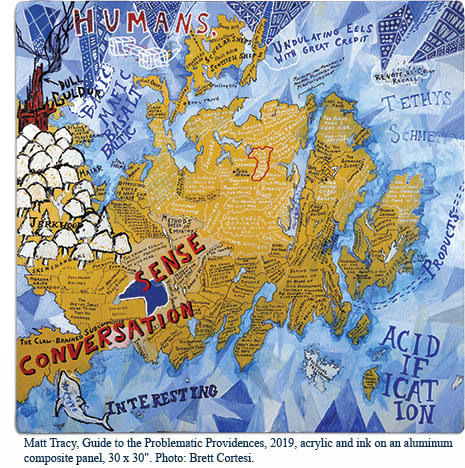
“A Providence, Rhode Island painter, Matt Tracy maps the absurd from personal to political,” says Jonny Skye, owner and curator of Skye Gallery. “Full of humor and paradox, Tracy creates landscapes of the mind and heart and exposes humanity’s relentless consumption as an imperialist clench of the earth.”
Tracy grew up in Connecticut, where he “found endless enjoyment in making crazy scrambled dubs on audiocassettes,” cutting up The New York Times to make “weird new articles,” and manipulating photocopies. Applying the lessons learned from those childhood projects, he now says, “My best solutions to problems, whether in creative work or in life in general, come when I allow chance and coincidence to play a role in my work process.”
Tracy’s landscapes, cityscapes, and maps stretch those forms to ridiculous results. In the maximalist painting Guide to the Problematic Providences the 43-year-old has created a giant map depicting countries divided into absurdly named regions such as Business Casual Frontier Alliance, Copper Provided Wealth, and The Crown Really Needs Protestants to Live Here. One cluster of islands is hilariously identified as Steak Tips, Stock Tips, Skull Bits, and Pizza Chips. “As images develop, layers of words and ideas begin to inflect them,” Tracy says, “offering commentary that ranges from coherent observation to wordplay, along with a healthy dose of apparent nonsense.” These absurdly insightful pieces investigate the natural progression of unchecked human expansion and mirror the artist’s dedication to agricultural and environmental issues, which deepened while Tracy co-owned and operated an organic farm for over 15 years.
Land, plants, and ecology are predominant themes in Tracy’s art since he returned to a regular studio practice in 2018. Recently, he propagated wild plants from the Woonasquatucket River watershed to create Invasive, an installation for the Storefront Window Gallery at the Dirt Palace in Providence.
From May through August of this year, he is exhibiting work examining the effects of European colonization on the ecology of New England with Deborah Spears Moorehead at Providence City Hall.
JACKSON TUPPER
BURLINGTON, VT
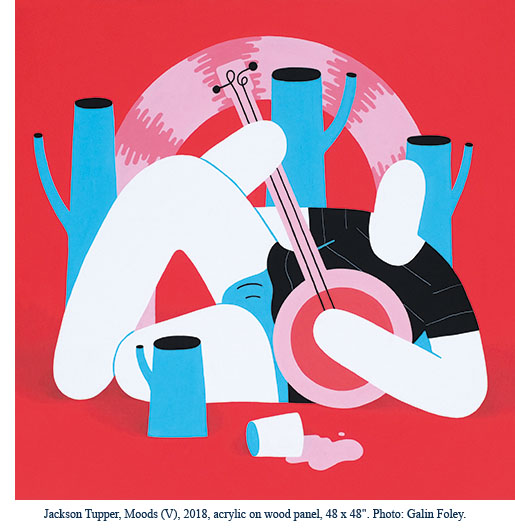
“Jackson Tupper’s multimedia creations explore subjects and narratives that seem to exist in a realm that hover slightly above our perception of reality,” says Kelly Holt, independent curator and curator at Spruce Peak Arts. “Much like a dream, his world is both familiar and unnatural, comfortably uncomfortable. An experimental mix of various media…Tupper’s studio brings a refreshing sense of humor and fearlessness to the landscape of contemporary art.”
Tupper, who is a native of Maine and a graduate of the University of Vermont, is both a commercial and fine artist. By day he is a designer at Burton Snowboards; by night he makes screen prints and works at the Iskra Print Collective in Burlington.
Tupper’s prints, animations, and wooden cut-outs of sensual, whimsical figures convey a marvelously twisted sense of humor—rifletoting women recline against a Big Gulp cup; faceless characters smoke, play instruments, skateboard, and make photocopied “dick pics.” As Tupper told Holt in an interview for the Vermont Art Guide, “Creating these characters forced me to loosen up. I realized how refreshing this was….My characters are kind of a reflection of my insecurities in how they are so opposite of me. Where I’m skinny and anxious, my characters are plump and carefree….They’re comfortable and confident in their own skin. In this way, art serves as the…outlet for people… to invent their better selves.”
The 28-year-old finds inspiration in a range of media, from the music of John Prine to the graffiti of Barry McGee, and is currently preparing for a solo show at Safe and Sound Gallery in Burlington.
DEVON KELLEY-YURDIN
Portland, ME

“Devon Kelley-Yurdin is an important voice,” says Marcia Minter, curator and co-founder of the Indigo Arts Alliance. “That their work is so graphic is no surprise as they seem to be rounding up everything they can to amplify their vision. Listen up!”
Before settling in Portland, Kelley-Yurdin grew up in Vermont, earned a degree from Pratt, and lived in Oakland, Austin, and Eastport, Maine. “I weave a wide net and carry a diverse tool belt…Play, curiosity, queerness, accessibility, equity, and skill-building drive my work.”
Kelley-Yurdin is “very question-driven and take[s] on most projects as a way to learn something…A lot of my projects right now are really process- and relationship-focused and open to the emergence of things that I couldn’t possibly yet know—it’s thrilling and healing for this recovering perfectionist.”
Works like Going For It, an ongoing amateur talent show that “serves as an exercise in bravery and community care” and the upcoming In Kinship Archives & Performance Fellowship—a yearlong process that follows the tradition of Wabanaki Guiding, connecting people to the Penobscot River through experience, language, and story—express Kelley-Yurdin’s dedication to being an “instigator of collective experiences.”
But the 34-year-old is also a self-described “cut-paper enthusiast,” who enjoys being “a collaborator with the other-than-human natural world.” In Other Nature: Black Sheep, cut paper replaces pine needles at the end of a branch. The elegant, mysterious folds of a new work defy the simplicity of the materials—tracing paper, tacks, and a clamp lamp. “Shadow work is like that too,” says Kelley-Yurdin. “It looks fancy from one side but the other side is just paper cuts taped to sticks stuck in cardboard boxes.”
In addition to the Kinship Fellowship, the artist is also preparing for a two-person show with Cecilia Ackerman at the University of New England Ketchum Library Gallery in Biddeford, ME, opening October 10.
Thanks to all of the nominators and artists for sharing these insights and stories with Art New England. To learn more about these artists and their work, please visit their websites listed below.
Michelle Aldredge is a writer, designer, and founder of the arts blog, Gwarlingo. She has been named a “Top 100 Artist, Innovator, Creative” by Origin Magazine. She is also co-author of Mirror Mirrored: A Contemporary Artists’ Edition of 25 Grimms’ Tales.
Megan Bogonovich
Norwich, VT, meganbogonovich.com
Brett Cimino
Glocester, RI, brettciminoart.com
Madge Evers
Haydenville, MA, sporeplay.com
Sara Inacio
Providence, RI, sarainacio.com
Glenn LaVertu
Middletown, CT, glenn-lavertu.squarespace.com
Jazzmen Lee-Johnson
Providence, RI, jazzmenleejohnson.com
Rosemary Mack
Dublin, NH, ant-rose.com
Matt Tracy
Providence, RI, matttracyart.com
Jackson Tupper
Burlington, VT, jacksontupper.com
Devon Kelley-Yurdin
Portland, ME, devonkelley-yurdin.com
